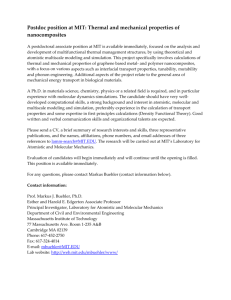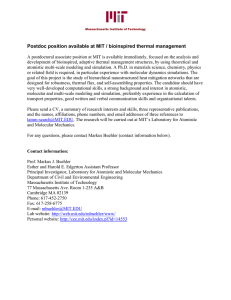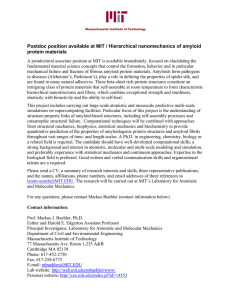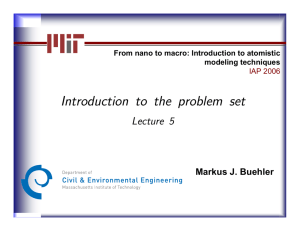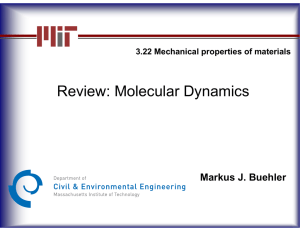Document 12886309
advertisement
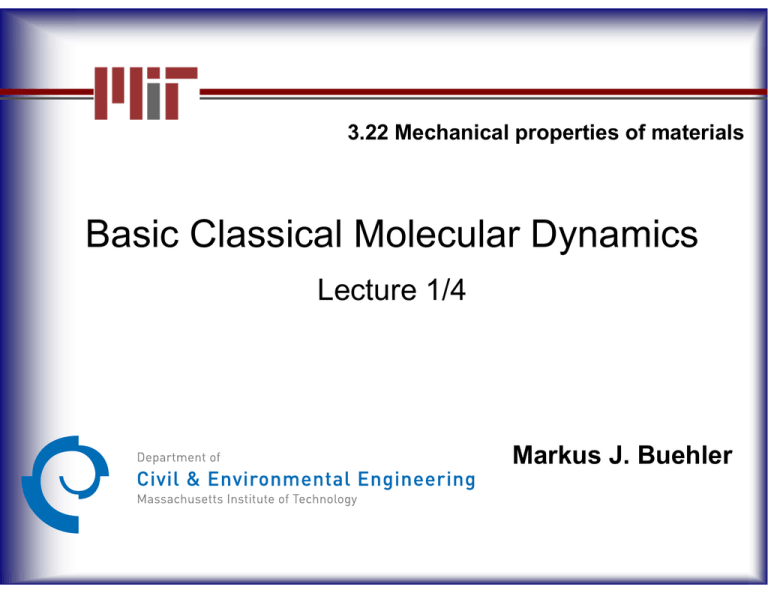
3.22 Mechanical properties of materials Basic Classical Molecular Dynamics xxx Lecture 1/4 Markus J. Buehler Outline: 4 Lectures on Molecular Dynamics (=MD) Lecture 1: Basic Classical Molecular Dynamics General concepts, difference to MC methods, challenges, potential and implementation Lecture 2: Introduction to Interatomic Potentials Discuss empirical atomic interaction laws, often derived from quantum mechanics or experiment Lecture 3: Modeling of Metals Application of MD to describe deformation of metals, concepts: dislocations, fracture Lecture 4: Reactive Potentials New frontier in research: Modeling chemistry with molecular dynamics using reactive potentials © 2006 Markus J. Buehler, CEE/MIT Some websites and Java applets Some Java applets: http://polymer.bu.edu/wamnet.html http://polymer.bu.edu/java/java/LJ/index.html Research website (if you are interested in UROP, thesis project or others): http://web.mit.edu/mbuehler/www/ © 2006 Markus J. Buehler, CEE/MIT Additional Reading Book Chapters Allen and Tildesley: “Computer simulation of liquids” D. C. Rapaport (1996): “The Art of Molecular Dynamics Simulation” D. Frenkel, B. Smit (2001): “Understanding Molecular Simulation” Movies: http://web.mit.edu/mbuehler/www/research/movies/m50-2.avi http://web.mit.edu/mbuehler/www/research/movies/mov-cam-1.mpg Lecture notes and publications © 2006 Markus J. Buehler, CEE/MIT Goal of the four lectures Provide students with a basic understanding of the main concepts in MD modeling Physical concepts Algorithms Bookkeeping Relation to other methods discussed in class Applicability – deformation, fracture, mechanical properties In particular, discuss: Strengths Weaknesses What problems can we apply it to? What do we need to be careful about? © 2006 Markus J. Buehler, CEE/MIT How to model materials Continuum viewpoint – no underlying inhomogeneous microstructure, that is, matter can be divided infinitely without change of material properties Discussed earlier in IM/S (e.g. finite element method) Atomistic viewpoint - consider the discreteness of matter – for example, the discreteness of an atomic lattice in a metal, where atoms are glued to their positions No spatial discretization necessary – given by atomic distances, e.g. lattice © 2006 Markus J. Buehler, CEE/MIT Historical perspective: Modeling of mechanical (behavior) of materials 1500-1600s: L. da Vinci, Galileo Galilei 1700-1800: Euler, Bernoulli Beam theories, rods (partial differential equations, continuum theories) Continuum Continuum mechanics theories Development of theories of fracture mechanics, theory of dislocations (1930s) 1960..70s: Development of FE theories and methods (engineers) 1990s: Marriage of MD and FE via Quasicontinuum Method (Ortiz, Tadmor, Phillips) Atomistic 20th century: Atoms discovered (Jean Perrin) MD: First introduced by Alder and Wainwright in the late 1950's (interactions of hard spheres). Many important insights concerning the behavior of simple liquids emerged from their studies. 1964, when Rahman carried out the first simulation using a realistic potential for liquid argon (Rahman, 1964). Numerical methods like DFT (Kohn-Sham, 1960s-80s) First molecular dynamics simulation of a realistic system was done by Rahman and Stillinger in their simulation of liquid water in 1974 (Stillinger and Rahman, 1974). First fracture / crack simulations in the 1980s by Yip and others, 1990s Abraham and coworkers (large-scale MD) Now: MD simulations of biophysics problems, fracture, deformation are routine The number of simulation techniques has greatly expanded: Many specialized techniques for particular problems, including mixed quantum mechanical classical simulations, that are being employed to study enzymatic reactions (“QM-MM”) or fracture simulations (Kaxiras and others…).© 2006 Markus J. Buehler, CEE/MIT Elasticity and atomistic bonding “atomistic” discrete “continuum” © 2006 Markus J. Buehler, CEE/MIT The problem to solve In atomistic simulations, the goal is to understand and model the motion of each atom in the material The collective behavior of the atoms allows to understand how the material undergoes deformation (metals: dislocations), phase changes or other phenomena, providing links between the atomic scale to meso/macro phenomena Figures by MIT OCW. © 2006 Markus J. Buehler, CEE/MIT Molecular dynamics MD generates the dynamical trajectories of a system of N particles by integrating Newton’s equations of motion, with suitable initial and boundary conditions, and proper interatomic potentials Particles with mass mi N particles ri(t) z vi(t), ai(t) y x © 2006 Markus J. Buehler, CEE/MIT Remarks MD is an alternative approach to MC by sampling phase and state space, but obtaining actual deterministic trajectories; thus: Full dynamical information In long time limit, and for equilibrium properties, the results of MC correspond to results obtained by MD MD can model processes that are characterized by extreme driving forces and that are non-equilibrium processes Example: Fracture © 2006 Markus J. Buehler, CEE/MIT Motivation: Fracture Materials under high load are known to fracture MD modeling provides an excellent physical description of the fracture processes, as it can naturally describe the atomic bond breaking processes Other modeling approaches, such as the finite element method, are based on empirical relations between load and crack formation and/or propagation; MD does not require such input What “is” fracture? © 2006 Markus J. Buehler, CEE/MIT Ductile versus brittle materials BRITTLE Glass Polymers Ice... DUCTILE Copper, Gold Shear load Figure by MIT OCW. © 2006 Markus J. Buehler, CEE/MIT The problem to solve Molecular dynamics of mechanics applications can be computationally challenging, due to Complexities of force field expressions (calculation of atomic forces) Large number of atoms and thus large number of degrees of freedom in the system (3N) To model realistic (macro-engineering) dimensions of materials with microstructural features: Need system sizes with ~1023 atoms (1 mole) This results in challenges for data analysis and visualization, or just for data handling and storage Much research has been done to advance data analysis techniques and visualization schemes (e.g., Vashishsta and coworkers at USC’s center for Advanced Computing and Simulation, http://cacs.usc.edu) © 2006 Markus J. Buehler, CEE/MIT Molecular dynamics Total energy of system E = K +U 1 N 2 K = m∑ v j 2 j =1 U = U (rj ) m d 2 rj dt 2 = −∇ r j U (rj ) j = 1..N Coupled system N-body problem, no exact solution for N>2 System of coupled 2nd order nonlinear differential equations Solve by discretizing in time (spatial discretization given by “atom size”) © 2006 Markus J. Buehler, CEE/MIT Solving the equations Solve those equations: Discretize in time (n steps), Δt time step: ri (t0 ) → ri (t0 + Δt ) → ri (t0 + 2Δt ) → ri (t0 + 3Δt ) → ... → ri (t 0 + nΔt ) Taylor series expansion 1 2 ri (t0 + Δt ) = ri (t0 ) + vi (t0 )Δt + ai (t0 )(Δt ) + ... 2 Adding this expansion together with one for ri (t0 − Δt ) : 1 2 ri (t0 − Δt ) = ri (t0 ) − vi (t0 )Δt + ai (t0 )(Δt ) + ... 2 © 2006 Markus J. Buehler, CEE/MIT Solving the equations + 1 2 ri (t0 + Δt ) = ri (t0 ) + vi (t0 )Δt + ai (t0 )(Δt ) + ... 2 1 2 ( ) ri (t0 − Δt ) = ri (t0 ) − vi (t0 )Δt + ai (t0 ) Δt + ... 2 ri (t0 + Δt ) = −ri (t0 − Δt ) + 2ri (t0 )Δt + ai (t0 )(Δt ) + ... 2 Positions at t0-Δt Positions at t0 Accelerations at t0 “Verlet central difference method” How to obtain accelerations? f i = mai ai = f i / m Need forces on atoms! © 2006 Markus J. Buehler, CEE/MIT Time-discretization Time step Δt needs to be small enough to model the vibrations of atomic bonds correctly Vibration frequencies may be extremely high, in particular for light atoms Thus: Time step on the order of 0.1..5 fs (10-15 seconds) Need 1,000,000 integration steps to calculate trajectory over 1 nanosecond: Significant computational burden… Time step can (typically) not varied during simulation; it is fixed © 2006 Markus J. Buehler, CEE/MIT Different thermodynamical ensembles Integrating the Verlet equations will: Conserve energy (E=const.) Keep number of particles constant (N=const.) Keep volume constant (V=const.) Thus: Yields an NVE ensemble (“microcanonical ensemble”) Other thermodynamical ensembles can be realized by changing the equations of motion (e.g. NVT – coupling to heat bath…, “canonical ensemble”) 1 N 2 K = m∑ v j 2 j =1 2 K T= 3 N ⋅ kB 3 Temperature ~K TNk B = K 2 Thus: changing velocities of atoms changes temperature (effect of heat bath) © 2006 Markus J. Buehler, CEE/MIT Typical modeling procedure Set particle positions Calculate force on each particle Move particles by timestep Dt Stop simulation Assign particle velocities Save current positions and velocities Reached max. number of timesteps? Analyze data print results © 2006 Markus J. Buehler, CEE/MIT Remarks Typically, have cubical cell in which particles are places in a regular or irregular manner “gas (liquid)” “solid - crystal” © 2006 Markus J. Buehler, CEE/MIT Periodic boundary conditions Sometimes, have periodic boundary conditions; this allows studying bulk properties (no free surfaces) with small number of particles (here: N=3!) – all particles are “connected” Original cell surrounded by 26 image cells; image particles move in exactly the same way as original particles (8 in 2D) Particle leaving box enters on other side with same velocity vector. Figure by MIT OCW. © 2006 Markus J. Buehler, CEE/MIT How are forces calculated? Recall: Forces required to obtain accelerations to integrate EOM… Forces are calculated based on the distance between atoms; while considering some interatomic potential surface (discussed later in this lecture) In principle, all atoms in the system interact with all atoms: Need nested loop 2 F= m d rj dt 2 = −∇ r j U (rj ) j = 1..N Force: Partial derivative of potential energy with respect to atomic coordinates © 2006 Markus J. Buehler, CEE/MIT How are forces calculated? Force magnitude: Derivative of potential energy with respect to atomic distance dV (r) F =− dr To obtain force vector Fi, take projections into the three axial directions xi Fi = F r F r x2 Often: Assume pair-wise interaction between atoms © 2006 Markus J. Buehler, CEE/MIT Minimum image convention Since in the pair potential approximation, the particles interact two at a time, a procedure is needed to decide which pair to consider among the pairs between actual particles and between actual and image particles. The minimum image convention is a procedure where one takes the nearest neighbor to an actual particle, regardless of whether this neighbor is an actual particle or an image particle. Another approximation which is useful to keep the computations to a manageable level is to introduce a force cutoff distance beyond which particle pairs simply do not see each other (see the force curve). © 2006 Markus J. Buehler, CEE/MIT Minimum image convention In order not to have a particle interact with its own image, it is necessary to ensure that the cutoff distance is less than half of the simulation cell dimension. Courtesy of Nick Wilson. Used with permission. © 2006 Markus J. Buehler, CEE/MIT Neighbor lists Another bookkeeping device often used in MD simulation is a Neighbor List which keeps track of who are the nearest, second nearest, ... neighbors of each particle. This is to save time from checking every particle in the system every time a force calculation is made. The List can be used for several time steps before updating. Each update is expensive since it involves NxN operations for an N-particle system. In low-temperature solids where the particles do not move very much, it is possible to do an entire simulation without or with only a few updating, whereas in simulation of liquids, updating every 5 or 10 steps is quite common. © 2006 Markus J. Buehler, CEE/MIT What makes MD unique… Unified study of all physical properties. Using MD one can obtain thermodynamic, structural, mechanical, dynamic and transport properties of a system of particles which can be a solid, liquid, or gas. One can even study chemical properties and reactions which are more difficult and will require using quantum MD. Several hundred particles are sufficient to simulate bulk matter. While this is not always true, it is rather surprising that one can get quite accurate thermodynamic properties such as equation of state in this way. This is an example that the law of large numbers takes over quickly when one can average over several hundred degrees of freedom. Direct link between potential model and physical properties. This is really useful from the standpoint of fundamental understanding of physical matter. It is also very relevant to the structure-property correlation paradigm in materials science. Complete control over input, initial and boundary conditions. This is what gives physical insight into complex system behavior. This is also what makes simulation so useful when combined with experiment and theory. Detailed atomic trajectories. This is what one can get from MD, or other atomistic simulation techniques, that experiment often cannot provide. This point alone makes it compelling for the experimentalist to have access to simulation. (adapted from Sid.© Yip, Nuclear Engrg./MIT) 2006 Markus J. Buehler, CEE/MIT MD modeling of crystals: Challenges of data analysis Crystals: Regular, ordered structure The corresponding particle motions are small-amplitude vibrations about the lattice site, diffusive movements over a local region, and long free flights interrupted by a collision every now and then. MD has become so well respected for what it can tell about the distribution of atoms and molecules in various states of matter, and the way they move about in response to thermal excitations or external stress such as pressure. Figure by MIT OCW. [J. A. Barker and D. Henderson, Scientific American, Nov. 1981]. © 2006 Markus J. Buehler, CEE/MIT Analysis of molecular dynamics data 2 K Temperature: T = 3 N ⋅ kB Pressure Potential contribution Kinetic contribution Why do we need information about temperature and pressure? The information on pressure, energy and temperature is useful to make sure that the system is well equilibrated and that nothing strange is happening during the entire simulation. Temperature etc. are macroscopic properties, and they do not tell us what is happening at the microscopic level (details averaged out)! © 2006 Markus J. Buehler, CEE/MIT Pressure, energy and temperature history Pressure 6.25 6.2 6.15 0.1 Energy -5.24 -5.26 -5.28 Temperature -5.3 0.4 0.38 0 5 10 15 20 25 Time Figure by MIT OCW. Time variation of system pressure, energy, and temperature in an MD simulation of a solid. The initial behavior are transients which decay in time as the system reaches equilibrium. © 2006 Markus J. Buehler, CEE/MIT Pressure, energy and temperature history Energy Pressure 5.4 5.3 5.2 -5.0 Temperature 1.38 1.36 1.34 1.32 0 20 40 60 80 100 120 Figure by MIT OCW. Time variation of system pressure, energy, and temperature in an MD simulation of a liquid: Longer transients © 2006 Markus J. Buehler, CEE/MIT Deformation of materials: Flaws or cracks matter “Macro” Stress σ Failure of materials initiates at cracks Griffith, Irwine and others: Failure initiates at defects, such as cracks, or grain boundaries with reduced traction, nano-voids © 2006 Markus J. Buehler, CEE/MIT Schematic of stress field around a single (static) crack tensile stress shear ¾ The stress field around a crack is complex, with regions of dominating tensile stress (crack opening) and shear stress (dislocation nucleation) © 2006 Markus J. Buehler, CEE/MIT Ductile versus brittle materials BRITTLE Glass Polymers Ice... DUCTILE Copper, Gold Shear load Figure by MIT OCW. © 2006 Markus J. Buehler, CEE/MIT Additional references http://web.mit.edu/mbuehler/www/ 1. 2. 3. 4. 5. 6. 7. 8. 9. 10. 11. 12. 13. 14. 15. 16. 17. 18. 19. 20. Buehler, M.J., Large-scale hierarchical molecular modeling of nano-structured biological materials. Journal of Computational and Theoretical Nanoscience, 2006. 3(5). Buehler, M.J. and H. Gao, Large-scale atomistic modeling of dynamic fracture. Dynamic Fracture, ed. A. Shukla. 2006: World Scientific. Buehler, M.J. and H. Gao, Dynamical fracture instabilities due to local hyperelasticity at crack tips. Nature, 2006. 439: p. 307-310. Buehler, M.J., et al., The Computational Materials Design Facility (CMDF): A powerful framework for multiparadigm multi-scale simulations. Mat. Res. Soc. Proceedings, 2006. 894: p. LL3.8. R.King and M.J. Buehler, Atomistic modeling of elasticity and fracture of a (10,10) single wall carbon nanotube. Mat. Res. Soc. Proceedings, 2006. 924E: p. Z5.2. Buehler, M.J. and W.A. Goddard, Proceedings of the "1st workshop on multi-paradigm multi-scale modeling in the Computational Materials Design Facility (CMDF)". http://www.wag.caltech.edu/home/mbuehler/cmdf/CMDF_Proceedings.pdf, 2005. Buehler, M.J., et al., The dynamical complexity of work-hardening: a large-scale molecular dynamics simulation. Acta Mechanica Sinica, 2005. 21(2): p. 103-111. Buehler, M.J., et al. Constrained Grain Boundary Diffusion in Thin Copper Films. in Handbook of Theoretical and Computational Nanotechnology. 2005: American Scientific Publishers (ASP). Buehler, M.J., F.F. Abraham, and H. Gao, Stress and energy flow field near a rapidly propagating mode I crack. Springer Lecture Notes in Computational Science and Engineering, 2004. ISBN 3-540-21180-2: p. 143-156. Buehler, M.J. and H. Gao, A mother-daughter-granddaughter mechanism of supersonic crack growth of shear dominated intersonic crack motion along interfaces of dissimilar materials. Journal of the Chinese Institute of Engineers, 2004. 27(6): p. 763-769. Buehler, M.J., A. Hartmaier, and H. Gao, Hierarchical multi-scale modelling of plasticity of submicron thin metal films. Modelling And Simulation In Materials Science And Engineering, 2004. 12(4): p. S391-S413. Buehler, M.J., Y. Kong, and H.J. Gao, Deformation mechanisms of very long single-wall carbon nanotubes subject to compressive loading. Journal of Engineering Materials and Technology, 2004. 126(3): p. 245-249. Buehler, M.J., H. Gao, and Y. Huang, Continuum and Atomistic Studies of the Near-Crack Field of a rapidly propagating crack in a Harmonic Lattice. Theoretical and Applied Fracture Mechanics, 2004. 41: p. 21-42. Buehler, M. and H. Gao, Computersimulation in der Materialforschung – Wie Großrechner zum Verständnis komplexer Materialphänomene beitragen. Naturwissenschaftliche Rundschau, 2004. 57. Buehler, M. and H. Gao, Biegen und Brechen im Supercomputer. Physik in unserer Zeit, 2004. 35(1): p. 30-37. Buehler, M.J., et al., Atomic plasticity: description and analysis of a one-billion atom simulation of ductile materials failure. Computer Methods In Applied Mechanics And Engineering, 2004. 193(48-51): p. 5257-5282. Buehler, M.J., F.F. Abraham, and H. Gao, Hyperelasticity governs dynamic fracture at a critical length scale. Nature, 2003. 426: p. 141-146. Buehler, M.J., A. Hartmaier, and H. Gao, Atomistic and Continuum Studies of Crack-Like Diffusion Wedges and Dislocations in Submicron Thin Films. J. Mech. Phys. Solids, 2003. 51: p. 2105-2125. Buehler, M.J., A. Hartmaier, and H.J. Gao, Atomistic and continuum studies of crack-like diffusion wedges and associated dislocation mechanisms in thin films on substrates. Journal Of The Mechanics And Physics Of Solids, 2003. 51(11-12): p. 2105-2125. Buehler, M.J. and H. Gao. "Ultra large scale atomistic simulations of dynamic fracture"; In: Handbook of Theoretical and Computational Nanotechnology. 2006: American Scientific Publishers (ASP), ISBN:1-58883-042-X.
